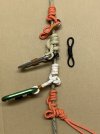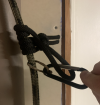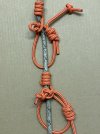John RB
Well-Known Member
Hey friends. Sorry I am late to the party. I posted a similar blurb in the Fricton Hitches thread earlier tonight...
I do my best to learn and use the correct terminology and so instead of writing things down in my own personal notes, I am regularly updating the dictionary on my website. It's a work in progress, but so is everything, right? Below is what I have gathered on the tend / tender / self tending topic. Comments welcome. By the way, using cordage as a tender is not something I have seen before. It's typically a rigid device so as to minimize rope rubbing on rope in a concentrated area.
tend / tender/ self tending
Tend: An action/verb causing the movement of a friction device in a desired direction. In rope climbing ascent, the friction device is tended upward for progress capture, removing / minimizing slack in the system.
Tender (or Tending Device) is a device which tends a friction hitch in the desired direction. Pulleys, rings and carabiners are commonly employed as tenders.
Self Tending: The literal definition applies : Tends itself. In the context of describing a system vs a hitch, there are subtle differences.
Self Tending System: A self tending system is one which has automatic progress capture, requiring no manual action to advance the friction device. Example: “Double Blake’s Hitch MRS System”. Note that a self tending system might use a tender.
Self Tending Friction Hitch: One which allows the removal of slack with only one hand by pulling on the tag end of the rope and without the use of a tender. Example 1: Shorten a Tether or Lineman’s belt with one hand. Example 2: Climber is connected to the tree via a friction hitch to a Lifeline which is secured to the tree. Climber steps up, introducing slack, and pulls the tag end of the rope outward and upward, removing the slack with one hand.
JrbTreeClimbing.com, affiliated with RockNArbor.com
I do my best to learn and use the correct terminology and so instead of writing things down in my own personal notes, I am regularly updating the dictionary on my website. It's a work in progress, but so is everything, right? Below is what I have gathered on the tend / tender / self tending topic. Comments welcome. By the way, using cordage as a tender is not something I have seen before. It's typically a rigid device so as to minimize rope rubbing on rope in a concentrated area.
Dictionary - JrbTreeClimbing.com
JRB's Dictionary for Saddle Hunter's Criteria for inclusion: 1) Useful to a large audience of Saddle hunters. 2) Brand agnostic, where possible. 3) Does not include a list of knots, only knot types and some examples. 4) Leave Feedback as appropriate. Get 10% discount using the JRB10 coupon code...
jrbtreeclimbing.com
tend / tender/ self tending
Tend: An action/verb causing the movement of a friction device in a desired direction. In rope climbing ascent, the friction device is tended upward for progress capture, removing / minimizing slack in the system.
Tender (or Tending Device) is a device which tends a friction hitch in the desired direction. Pulleys, rings and carabiners are commonly employed as tenders.
Self Tending: The literal definition applies : Tends itself. In the context of describing a system vs a hitch, there are subtle differences.
Self Tending System: A self tending system is one which has automatic progress capture, requiring no manual action to advance the friction device. Example: “Double Blake’s Hitch MRS System”. Note that a self tending system might use a tender.
Self Tending Friction Hitch: One which allows the removal of slack with only one hand by pulling on the tag end of the rope and without the use of a tender. Example 1: Shorten a Tether or Lineman’s belt with one hand. Example 2: Climber is connected to the tree via a friction hitch to a Lifeline which is secured to the tree. Climber steps up, introducing slack, and pulls the tag end of the rope outward and upward, removing the slack with one hand.
JrbTreeClimbing.com, affiliated with RockNArbor.com




